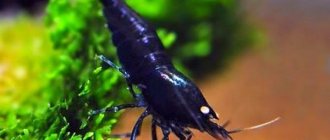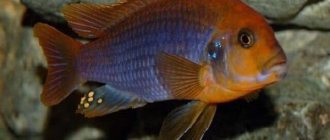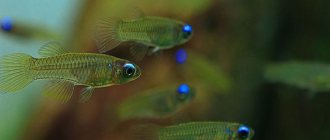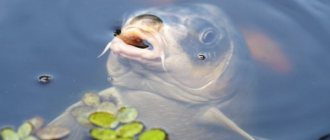Chitala ornata is an aquarium species of fish, more familiar to aquarists under the name Indian knife. Representatives of this species are unusual in all respects - from color to character and disposition. They will not playfully wag their tails among the plants and shimmer their scales in the glare of light; these fish are not cute and do not have a good character. Their instincts are to hunt and kill. Although in appearance, when you first meet, one is struck by grace, aristocracy and self-esteem.
Life in the wild
The habitats of the Indian knife are Southeast Asia (Thailand, Vietnam, Cambodia, Laos). The species is not endangered, although it is popular among the local population exclusively as a delicious lunch dish. Hitala ornata loves to live in lakes, swamps and large river backwaters. In their youth they live in small groups, preferring a hidden lifestyle. Most of the time they hide among dense plants and snags submerged in water.
As they grow older, they become loners. During the hunt, they hide in ambush, lying in wait for their prey and waiting for the right moment to attack. They do not experience discomfort if they have to be in stagnant water with a low oxygen content.
Recently, the Indian knife began to live in the USA, in the state of Florida. The appearance of this species in an atypical place is explained by the fact that several representatives of this species were once released into natural bodies of water by aquarists. Relatively suitable living conditions allowed them to actively reproduce and destroy local fish species.
Description of appearance
An Indian knife in its natural habitat can reach a length of up to 1 m and weigh about 5 kg. But representatives of the species living in aquariums have more modest physical parameters. The length of the aquarium chital ornata ranges from 25 to 50 cm.
The main color is gray with a silvery tint, the anal and dorsal fins are elongated in length, fused together, and move in a wave-like manner, which gives the fish a special appearance. There are dark-colored spots throughout the body that have different sizes and shapes. In each individual, the shape, number and color of the spots are individual, like human fingerprints.
head is small, its eyes are expressive, and its mouth seems small at first glance, but it is not so. The jaws are large and massive, designed in such a way that they can swallow large amounts of meat. Knives are considered long-lived, as their life cycle is 8-15 years.
Feeding
Ornata is a carnivore, and most of its diet consists of animal feed. This fish is especially fond of small living organisms: small fish, tadpoles, crustaceans, earthworms, etc. Young knives are excellent at eating bloodworms, tubifex and brine shrimp.
But if providing live food is difficult, it doesn’t matter, these predators can be switched to frozen food and minced fish, tubifex and squid, the main thing is to do this gradually. He shows little interest in dry food, and it is extremely difficult to accustom your pet to it.
Don’t forget about vegetable supplements, adding zucchini, cucumbers, apples, etc. to your pets’ diet.
Content Features
Chitala Ornata can only be purchased by experienced aquarists; it is not at all suitable for beginners.
The volume of the aquarium must be at least 300 liters.
The more free space there is for the fish, the larger the size it will reach. The difficulty in keeping this species is that when moving to a new aquarium (after purchasing it at a pet store), the knives have a very difficult time going through the acclimatization period, which is why they can die within a short period of time.
But if representatives of this species manage to survive in new conditions, their health will not be threatened in the future. Adults are distinguished by incredible physical endurance and are completely not susceptible to any diseases.
The aquarium must have a powerful external filter. The best option is a filter equipped with a UV stabilizer, since knives have increased sensitivity to medications. According to aquarists, it is better to prevent any diseases by carrying out timely prevention. Required water parameters:
- hardness – from 5.5. up to 10 Dgh;
- acidity – from 6.0 to 6.5 pH;
- temperature range – from +25° to +34°C.
Like all hunters, the Indian knife feels more comfortable in the twilight. The aquarium must contain decorative devices that serve as a kind of shelter - castles, jugs, grottoes and driftwood. It is imperative to plant dense plants.
Despite their pronounced hunting instinct and killer nature, representatives of this species are timid. If the knife does not find a place to hide at the moment of danger, it will be in a state of constant stress, which will negatively affect its nervous system.
The inability to hide in a secluded place will force the fish to hide in corners and hit the glass of the aquarium, as a result of which it can cause injuries that are dangerous to its health and life. Those places in the aquarium that cannot be planted with thickets are recommended to be shaded with floating plants.
Every week the aquarium must be cleaned and 2/3 of the water volume replaced (read more about correct water replacement in an aquarium). The Indian knife clogs the aquarium very quickly, so you need to be especially careful about cleanliness. The lid of the aquarium must be closed, since Indian knives are fast fish that have a habit of jumping high. Often their jumps end with them jumping out of the aquarium.
When purchasing an Indian knife, it is important to focus on the size of the individuals. You cannot buy fish smaller than 7 cm; such small fish will be very sensitive to water quality and can die quickly. Also, you should not purchase those representatives of the species whose body length is more than 16 cm, since they are very difficult to acclimatize and will be extremely difficult to transfer to other types of food.
Nutrition
Hitala ornata is an absolute predator. In their natural habitat, their diet consists of small fish, shrimp, snails and crabs. Individuals living in an aquarium should be fed small fish, invertebrates and worms. The diet of growing fish and adults is different. For fish, it is recommended to periodically provide vegetable feeding, giving cucumbers, apples, and zucchini.
Teen Menu
The diet of teenagers consists of:
- frozen brine shrimp;
- frozen bloodworms;
- squid;
- chicken;
- fillet of fish.
Chicken meat should not be given to fish often; this product is introduced into the diet gradually and in small quantities; the fish must be allowed to get used to the taste of chicken. Teenagers can be given flakes, but they will be extremely reluctant to consume this food, since fish need food enriched with protein.
Diet of adults
The nutrition of a sexually mature Indian knife is exclusively protein. The diet should be:
- squid;
- fish fillet;
- small live fish;
- mussels;
- chicken liver.
Aquarists who want to keep chital ornata should be prepared for the fact that such food will not be cheap. It is better to feed the fish protein food every other day, always collecting uneaten food so that the fish does not overeat.
Some aquarists are taught to feed the Indian knife from their hands, but in this practice you need to be very careful, since the fish is very shy even without outside intervention.
Despite the fact that chicken meat contains a large amount of protein, you cannot constantly feed fish with this product, otherwise it will result in the development of obesity and frequent constipation.
Feeding
The Indian knife is a predator. In the wild, they mainly eat fish, shrimp, crabs and snails. In the aquarium they also eat small fish, as well as worms and invertebrates.
When purchasing an Indian knife, avoid buying fish smaller than 7 cm and larger than 16. Small ones are very sensitive to water, and larger ones are difficult to accustom to other types of food.
Feeding teenagers
A teenager can be fed small fish - guppies, cardinals. They also eat frozen brine shrimp, but they like frozen bloodworms much more.
It may make up the majority of the diet until the fish matures. He eats flakes poorly, he can get used to granules or tablets, but this is not the best food, he needs live protein.
Fish fillet, squid meat, chicken, the same can be used
But it is important to give them not often, but to gradually accustom them to their taste, since in the future this will be the main source of nutrition for adult individuals.
Feeding adult fish
Adults can lighten your wallet well, as they eat quite expensive food.
But they need to be fed such food once every two or three days, and given pellets in between.
Indian knives are capricious and may refuse food that you offer them, you will see how adult individuals refuse food that they were happy to eat before.
For adults, the main diet is protein. Squid, fish fillets, live fish, mussels, chicken liver, all these are by no means cheap products. It is advisable to regularly feed with live food - fish, shrimp.
It is important not to feed them protein foods daily, skip a day between feedings, and be sure to clean up leftover food. You can get used to feeding by hand, but it is not recommended to do this, as the fish are quite shy
Character and friendliness with neighbors
Despite the hunter's temperament, Indian knives have a relatively calm disposition; they will coexist quite peacefully in the same aquarium with other similar large fish. The exception is when there are many other inhabitants in the aquarium, and the Indian knife will feel discomfort due to insufficient free space, as a result of which it may enter into conflicts with neighbors over territory.
The best neighbors will be:
- pangasius;
- stingray;
- shark ball;
- kissing gourami;
- arowana.
There should not be fish in the aquarium that are smaller in size than the Indian knife, as it will immediately begin to show its hunting instinct, and as a result, small fish will simply be eaten.
Compatibility
They are mostly peaceful fish in relation to species that they will not be able to eat. Please note that they have poor eyesight and sometimes they may try to eat fish that they obviously cannot swallow. This can severely damage the victim.
Possible neighbors: plecostomus, large synodontis, shark baloo, stingrays, arowana, kissing gourami, pangasius, pterygoplichthus and others.
It is not recommended to keep with aggressive species.
Features of reproduction
The Indian knife takes quite a long time to mature; an individual becomes sexually mature at about 3 years of age. The likelihood of reproduction in captivity is quite low, since the pair requires a lot of free space.
Spawning is possible only if a pair of Indian knives is provided with a tank of about 2 tons with certain water parameters.
During the spawning period, the female lays eggs on the leaves of plants; the number of eggs varies from 2 to 10 thousand; they are small and yellow in color. During the incubation period, which lasts from 5 to 7 days, the male does not swim away from the eggs, fiercely protecting his future offspring. To prevent the eggs from souring and to ensure that they receive a sufficient amount of oxygen, the male fans the clutch with his fins.
The fry that are born feed on what remains in the gall sac, and after 4 days, when they have already learned to swim, they come out of the shelter in search of food. It is recommended to place the young fish in the aquarium along with crustacean representatives, which will later serve as food for the developing fry.
Zooplankton, branchiopods, and brine shrimp are used to feed the fry. Small Indian knives are distinguished by their quarrelsome nature, often attacking each other, nibbling off fins and tails. As in the case of adult specimens, food should not be kept in the aquarium for a long time, so that its remains do not clog the aquarium.
Breeding
By the age of three, the ocellated knife becomes sexually mature. For breeding, fish are placed in a separate aquarium one meter long. Various shelters are installed at the bottom, flat stones are placed, and floating plants are also placed.
Suitable water temperature is 26–28 °C, hardness is up to 5 °, pH is 6.0–6.5. During the incubation period, which lasts almost a week, the male takes every possible care of the future offspring: he protects and cleans the eggs from settling organic residues. In addition, using the oscillatory movements of the caudal fin, the male ensures a constant flow of water to the eggs. As soon as the fry appear, they are immediately transplanted into a nursery aquarium. Artemia nauplii serve as starter food.
Indian knife - whether or not to have a predator in the aquarium
Despite all the difficulties of keeping chital ornate, this species is popular among aquarists. But before you decide to have such an unusual aquarium resident, you need to weigh all its advantages and disadvantages.
The advantages include an unusual color and an eye-catching appearance - representatives of this species will be a bright decoration for any aquarium. You can watch Indian knives, their smooth movements, in which the scales shimmer with silver, for hours.
Another advantage of purchasing an Indian knife is availability. You may get the impression that the Chitala Ornata fish is very rare and can only be purchased by pre-order. However, it is not. This aquarium species can be purchased at any pet store. The price of the fish is affordable; any beginning aquarist can purchase representatives of this species. Whether he can then arrange the proper conditions for her is another matter.
The Indian knife has few disadvantages: its predatory nature and the fact that it is not recommended for beginners to purchase. Only an experienced aquarist who knows how to observe a number of certain conditions in the aquarium will be able to keep such a fish.
The Indian knife is a representative of aquarium fish, which, if you have the appropriate experience, skills, knowledge and the opportunity to start a large aquarium, is worth purchasing. If the fish has easily overcome the acclimatization period in its new place of residence after purchase, it will be physically hardy and not susceptible to any diseases. Diseases can only occur due to improper conditions and feeding. Fish can die due to too low water temperature, improper hardness, or excessively bright lighting.
Diseases
With proper care and a balanced diet, apteronotuses are rarely susceptible to disease. Basically, fish can suffer from the following ailments:
- Ichthyophthiriasis - this disease manifests itself in the form of white dots located throughout the body. To treat the disease, it is necessary to add a small amount of salt to the water or transplant the infected individual into a separate container with a salt solution prepared at the rate of 3 g per 1 liter of water.
- Acidosis is a disease that develops due to low acidity of water. Its characteristic signs are a decrease in the activity of the individual, slowing down of movements, convulsive contraction of the gills, and the appearance of milky white spots on the body. If such symptoms are present, it is necessary to gradually increase the acidity level of the water by adding a little regular baking soda: no more than 3 g per 100 liters of water.
Did you know? The most expensive aquarium in the world costs $5 million and is made of pure gold. It's called
"
Golden Dragon
"
.
One of the advantages of representatives of this genus of fish is their ability to quickly recover from illness or injury. An extraordinary and graceful knife fish can become a real decoration for your home aquarium. She is graceful and pretty, has a peaceful and kind disposition, and always attracts the attention of others. However, only competent maintenance and proper balanced nutrition will enable Apteronotus to always be healthy and active.











